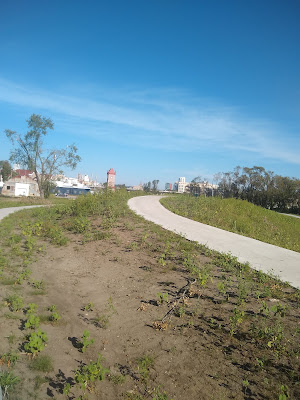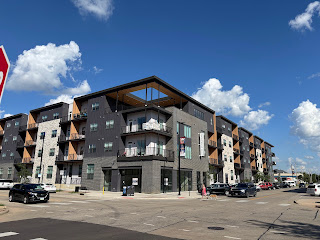 |
After the derecho, can we choose how to recover?
|
What kind of communities will we rebuild, when we rebuild them? As summer turns into fall, Americans continue to live in "interesting times," with the coronavirus running unabated, the economy staggering, and the President and his allies adding to the chaos. In my region, we're digging slowly out of the wreckage brought by an incredible derecho storm on Monday, August 10. At some point, however, the storms will have passed, and we will turn to the tasks of reconstructing our social order. We could try to put everything back the way it was before March 2020, but even if it were a good idea replication is probably impossible. So what should our goal(s) be?
 |
"Market Day" by Nancy Maybin Ferguson depicts 1910s Provincetown RI
|
New York Times columnist Jane Brody (2020) recommends what we might call the social city, inspired by her re-reading of Consequential Strangers: The Power of People Who Don't Seem to Matter--But Really Do by Melinda Blau and Karen L. Fingerman [W.W. Norton, 2010]. Fingerman told Brody that the "basic human need" of belonging is based on multiple casual encounters every day, what the authors call "weak ties." Brody agrees:
In my country house, especially during the dark, cold days of early spring, I would have been far more isolated. Yes, I could walk my dog and ride my bike without having to wear a mask because I would have met almost no one else on route. But I would also have been deprived of conversations with the many 'consequential strangers' I encountered daily during my outdoor excursions in Brooklyn, including the 7 p.m. 'shout-out' in support of our essential workers.
City design and policies for development have consequences for social encounters. "In their book," further notes Brody, "Ms. Blau and Dr. Fingerman emphasize the importance of creating and being in environments that foster relationships with consequential strangers." This will resonate with advocates of walkable cities and third places, which foster those encounters in ways that car-dependent suburbia and enclaves do not.
 |
Metro area bike trails are an attractive amenity
|
Bloggers for the Brookings Institution report on the Global Cities Initiative, which advises cities on finding their places in the global economy (Clark et al. 2020). The economic city, like any business, needs to identify and communicate its identity--not the same as a brand, being the reality on which a successful brand is based--to current and potential residents, employers, customers, and investors. "Cities that convey distinctive and differentiating character based on a coherent, genuine identity," they write, "are more competitive and gain new opportunities--once the world knows their story." The GCI lists seven sequential tasks in this process, with the key step being #5, where "a metro area must undertake an iterative process to translate values and assets into a narrative that resonates with internal and external audiences." This can inform the recovery process: What are the aspects of our area's identity the enhancement of which we should prioritize?
In an August 9 interview with Cedar Rapids Municipal Band director (and Coe College professor) Steve Shanley, Brad Hart, mayor of Cedar Rapids, stressed the town's combination of urban amenities (esp. performing arts, trails system), low cost of living, and easy commuting, all of which also inform our longtime slogan, the City of Five Seasons. Is that our global identity? How can our recovery improve these qualities? And who benefits from highlighting these particular qualities?
 |
| Czech Village Levee two-fer! Bike/walk trail on flood wall. |
|
In April the National Public Radio show On Point hosted a discussion of the qualities of a healing city; in the words of host Meghna Chakrabarti, "reimagining cities as places for better human health." Ken Greenberg, a Toronto-based urban planner and guest on the show, began by noting how the suburban model of development since World War II gave more space to automobiles at the expense of places to walk (or cycle)--along with more mechanical buildings sealed for climate control. He believes that the pandemic-inspired shift in the use of urban space back to non-vehicular activity will be to some degree permanent, with benefits for human health. Allowing for natural airflow is "not only a mitigation strategy, but will reconnect us to the climate around us," but that requires different kinds of design that are suited to specific local climates. Architect Michael Murphy pointed out that buildings were all built that way before technology made air conditioned boxes possible. The guests also talked about climate change and socio-economic inequities. In an online blog "diary," Greenberg suggests that various design changes can be integrated in ways that promote the health and well being of all:
Putting together all these pieces — laneways, street redesign, ravines, hydro corridors, rail lines, stormwater management systems, flood-proofing plans, and transportation initiatives, a vastly expanded public realm can emerge, one that addresses many of the city’s current deficiencies. This new realm will be different, both in scale and kind. Rather than discrete public spaces carved out of a grid of street blocks — parks and squares — this new kind of public space has the potential to become the fully continuous, connective tissue of the urban fabric itself.
The entire city can become more park-like, green, and connected for people on foot and on bicycle. Fostering residents’ ability to move around relatively freely and experience more of the city this way will help to break down the perceived barriers between neighbourhoods and districts as flows become more continuous. The elements of the public realm that serve as links between areas will play a vital role in helping to make the city feel like a seamless whole (Greenberg 2020).
What if we made improvement of human well being, particularly that of the most vulnerable citizens, a goal of future city development and design?
 |
Washington High School Step Team: Does creative activity lead to better thinking?
|
|
Another value worth pursuing is creativity, commended to cities by Richard Florida (The Rise of the Creative Class--and How It Is Transforming Leisure, Community and Everyday Life [Basic, 2002]) and Charles Landry (The Creative City: A Toolkit for Urban Innovators [Earthscan, 2nd ed, 2008]). A creative city is one where "fresh thinking" is brought to bear on
community problems (p. 49). This involves thinking about the community
as an integrated organism, not a series of unconnected processes where
getting the right outputs is merely a matter of expertly identifying the
right inputs.
The technical skills of an engineer
or physical planner will remain essential, but to solve most urban
problems they will need to be integrated with other skills, especially
in the human and social sciences. Knowledge of history, anthropology,
cultures, psychology has been lost in urban affairs. A traffic or zoning
issue is never only about cars or land use. If transport planners had
had a better understanding of psychology or culture or of the ideas of
mental geography, they would have been more careful about building urban
motorways with routes that scorch their ways through communities. The
crime and social problems that ensue are then picked up by others who
try to re-create some coherence for inhabitants (pp. 54-55).
This is about more than art, music, theater and dance. Yet "[b]ringing an artist into urban regeneration" can unleash "a new kind of creativity," as in Batley, England, where arts festivals helped changed "local self-respect, social cohesion and liveliness" in a way that facilitated improved living conditions (p. 147). So cities can learn from each other, while avoiding the same old stuff like corporate subsidies, subdivisions in cornfields, and "game-changer" tourist attractions.
This requires first breaking down decades of practice seeing problems narrowly: my street, my parking place, my experience of traffic congestion or ambient noise. Only then can planners and citizens "research and map with a greater chance of uniqueness and specialness of a place (emphasis mine) rather than merely seeing a partial picture of problems and opportunities.... It provides a constructive working environment with people more involved and responsible connecting with a wider network of organizations and residents. It thus makes a city more competitive" (p. 71).
Landry draw on a wide range of literature on cities and the creative process, provides a host of examples (in gray boxes), and has advice for cities in a variety of situations. Most of his book is designed to be consulted rather than read. His list of preconditions for creative urban policy (ch. 5) is long but useful. It includes: a mix of outsiders bringing fresh eyes and insiders with institutional memory; a cultural willingness to "break rules" and even to fail; a sense of local identity; and public space that facilitates exchange. "The idea of the public realm is bound up with ideas of discovery, or expanding one's horizons, of the unknown, of surprise, of experiment and of adventure" (p. 119). Practicing the creative arts can help everyone re-see the places where they live.

What shall be our animating value in rebuilding/recovery? I don't want to pick just one, as we at the Holy Mountain blog are not about reductionism, and certainly not into reductionism-ism. But note that the features of the social city are cited as prerequisites for both the healing city (Greenberg 2020) and the cultural city (Landry 2008: 119). If we subject every plan to the question "How does this help people mix?" instead of "Where are the cars going to park?" we'll be taking a giant step towards communities that are healthier, more equitable, more creative, and more resilient. And as someone said--please help me remember who!--if you build a place where people want to live, you'll have built a place where people want to visit, invest, run businesses, and such.
SEE ALSO: Richard Florida and Michael Seman, "Lost Art: Measuring COVID-19's Devastating Impact on America's Creative Economy," Brookings, 11 August 2020
















